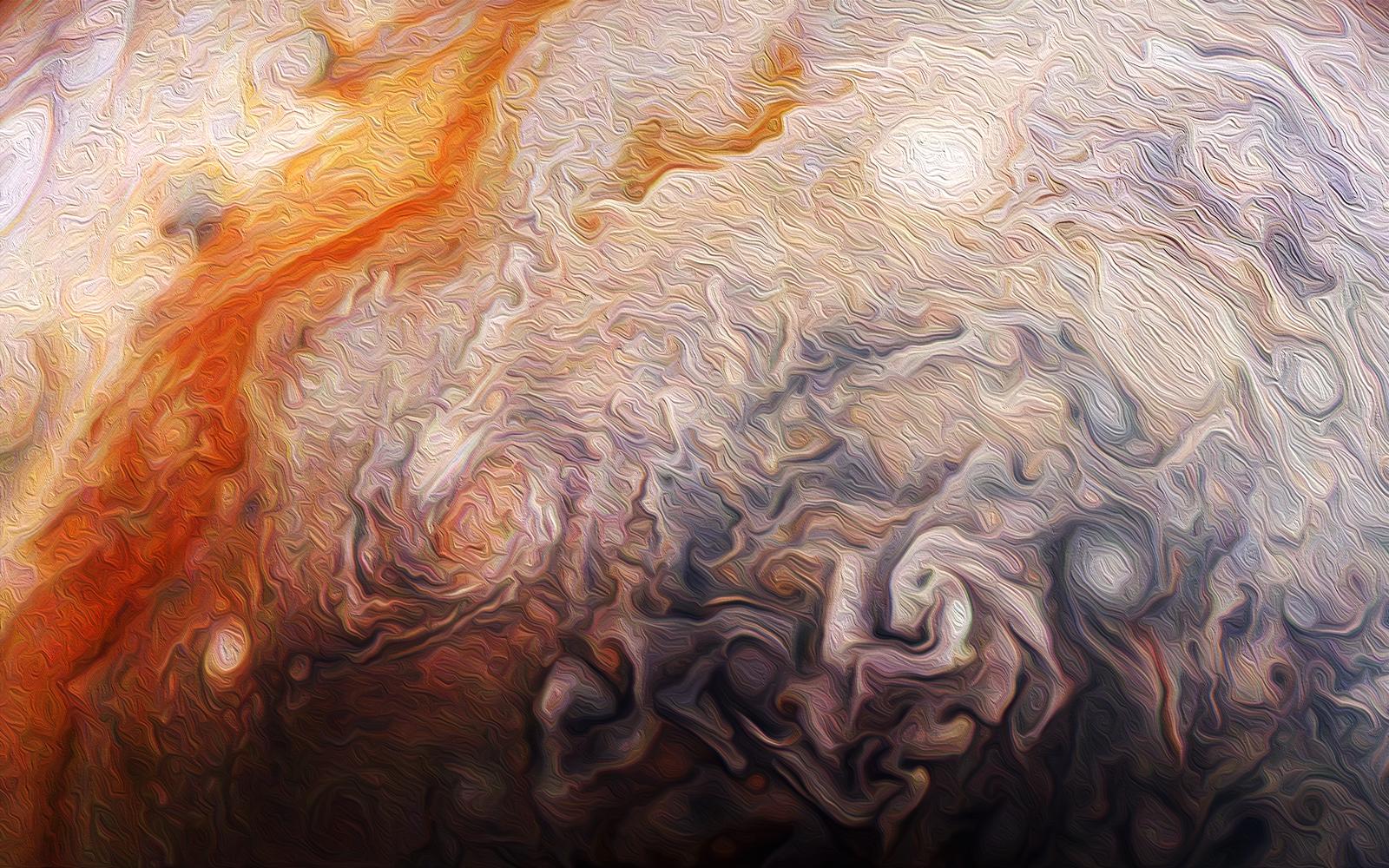
Posted on 04/19/2025 2:07:04 PM PDT by MtnClimber
Explanation: In digital brush strokes, Jupiter's signature atmospheric bands and vortices were used to form this interplanetary post-impressionist work of art. The creative image from citizen scientist Rick Lundh uses data from the Juno spacecraft's JunoCam. To paint on the digital canvas, a JunoCam image with contrasting light and dark tones was chosen for processing and an oil-painting software filter applied. The image data was captured during perijove 10. That was Juno's December 16, 2017 close encounter with the solar system's ruling gas giant. At the time the spacecraft was cruising about 13,000 kilometers above northern Jovian cloud tops. Now in an extended mission, Juno has explored Jupiter and its moons since entering orbit around Jupiter in July of 2016.
For more detail go to the link and click on the image for a high definition image. You can then move the magnifying glass cursor then click to zoom in and click again to zoom out. When zoomed in you can scan by moving the side bars on the bottom and right side of the image.

🪐 🌟 🌌 🍔
And that’ll be just what it looks like when we get there.
Very cool. That makes me feel super connected to love.
Congratulations, you’re an astronaut!
How great Thou art....
Wow.
Now that she’s back in the atmosphere
With drops of Jupiter in her hair
Hey, hey, hey
She acts like summer and walks like rain
Reminds me that there’s a time to change
Hey, hey, hey, hey
‘‘Twas Hunter Biden that brushstroked this work of art…
Amen
I’ve asked before but got crickets... I’d like to ask again... has anyone ever seen video of those swirls moving from any of the footage to date. I know its a long distance even for the orbiters, but since guesstimated wind speeds on Jupiter are up around 800mph, I wondered if any video ever caught movement.
There are a number of videos on YouTube showing movement in the area of the red spot on Jupiter. The first one that popped up when I searched was from 2024 so they are fairly current.
The orbiter passes are too fast to see movement. Earth telescopes may have captured movement. I will search. It interests me too.
i’ll be damned... theres movement in the surround clouds as well!! Thankyou!!
This Mesmerising New Video Shows The Churning Motion of Jupiter's Clouds
,p> Juno has been sending home some incredible postcards of Jupiter, with one slightly frustrating caveat: because of the data transfer limitations, they are, by necessity, still pictures. Now an amateur scientist has used those photographs to extrapolate an animation of Jupiter's clouds, and the results are just jaw-dropping. Gerald Eichstädt is a member of the Planetary Society who works as a mathematician and processes Juno imagery in his spare time. He created the video from two images taken by JunoCam on April 1 of this year. The photos were taken about 8 minutes and 41 seconds apart, from a distance of 24,749.4 kilometres (15,378.6 miles) above the cloud tops. They show the intricate whorls and crimps of Jupiter's turbulent clouds, snapped as the orbiter swung around from the planet's South Pole. Eichstädt reprojected the two images so that they could fit the same vantage point. This allowed him to directly compare them, more accurately gauging the changes in the clouds. He then modelled the movement of individual pixels to create an animation of how the clouds got from point A to point B.
Because the initial image taken by JunoCam only show a portion of the planet's surface, Eichstädt rendered four other images, also taken by JunoCam along the same trajectory, to fit the same viewing geometry. Doran then processed the image - smoothing the edges, adjusting the colours, filling the gaps - to make it look like a cohesive whole, rather than a mosaic. "It's something of a labour of love that requires plenty of patience," Doran said. "Energetic particles impact the CCD and produce bright specks. Once I'd finished the processing, I needed to go through and repair a couple hundred of these bright pixels." The pair presented their work at a Juno workshop held by the Royal Astronomical Society in London this week. "This animation represents a 'feasibility test'," he explained. "Building on this initial work, we can add in more variables that will give us a more detailed description and physical understanding of Jupiter's atmosphere."
Seán Doran, another Planetary Society citizen scientist and a visual artist, worked with Eichstädt to create a composite image of Jupiter, with the region showing towards the planet's South Pole (you can see it at the top of this page, and an image highlighting the exact region below).
Btt!!
It looks like a cheeseburger being eaten by a wolf.
Remind me of the short story “Desertion” by Clifford D. Simak. 1944
Plot Summary:
In “Desertion,” humanity has established a base on Jupiter’s moon, Callisto, and developed a process to convert humans into Jovian life forms that can survive Jupiter’s intense pressure and atmosphere. These transformed beings are sent to explore Jupiter — but none have ever returned or reported back.
The story follows Kent Fowler, the director of Dome #6, who decides to undergo the conversion himself after multiple scientists disappear. Once transformed, Fowler discovers that Jupiter is breathtakingly beautiful and spiritually liberating in his new form. He experiences a sense of connection, freedom, and understanding far beyond human experience — and like the others before him, chooses not to return.
It’s a powerful, poetic tale about transcendence, perception, and the limits of human experience — a standout in classic science fiction.
Disclaimer: Opinions posted on Free Republic are those of the individual posters and do not necessarily represent the opinion of Free Republic or its management. All materials posted herein are protected by copyright law and the exemption for fair use of copyrighted works.